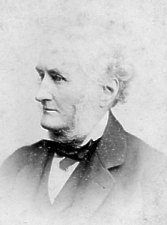
G. W. Dumbell - dated on back to 1873 © F Coakley collection

G. W. Dumbell - dated on back to 1873 © F Coakley collection
Chappell states his parents were Jonathan Dumbell (d. 1827) and Anne Davies, daughter of the Rector of Flint, North Wales (though no marriage ceremony was traced). Jonathan was the second son of William and Ann Dumbell who had developed substantial cotton interests around Warrington; other interests were in copper, corn and land. The Flint connection having developed when he, together with sons John (b. 1767 d. 1831) and Jonathan, opened a cotton mill at Holywell; the family had sold their shares in this in November 1790 though Jonathan continued as a dealer in Holywell. William, descended from a mill owning family, died late 1786/early 1787 - his son John wrote in 1814 'my ancestors as far as I can trace them were so far millers as to have mills in their own hands, or on their estate; and that I have been used to mills from my cradle: that I now have on my patrimonial freehold a water corn mill with 20 pair of stones, driven by the river Mersey and situate on the bank of that river' - this was the extensive Mersey Mills at Howley, Warrington. John remained in Warrington and in later life wrote a number of pamphlets to those in authority on various inventions or improvements to public services (injustices of Corn law; need for a bridge at Runcorn, price of bread, mills on the Thames etc. etc.).

John Dumbell
[from MS version of Kendrick's Portraits of Warrington
Worthies]
It was a natural progression to cotton mills - the ending of the American War in 1783 and the expiry of Arwright's water frame patents in 1785 encouraged the rapid adoption of Crompton's mule and a boom period in Lancashire ensued. However the banking industry was in its infancy, and the need for extensive credit led to the foundation of many local banks; and often to their demise during downturns in the business cycle. The Dumbell brothers and three other partners opened the Stockport Bank in 1791; it closed in 1793 during possibly the worst low in the business cycle provoked by the French declaration of war in February of that year. Giles states: 'Entrepreneurship had become a victim of the trade crisis, but in this case over-ambition and inexperience among the bank's partners contributed largely to its downfall'. It would appear that much credit had been drained off by the brothers to rebuild their Howley Mills. Bankruptcy laws were at that period unreformed and subject to large numbers of delaying tactics and malpractice (the affairs of the Stockport Bank were quoted in the textbooks etc as an example of the need for reform, which came in 1831). John Dumbell's creditors managed to sue out a commission of bankruptcy against him but suits against the co-partnership failed and the creditors and debtors agreed to a composition administered by trustees - 'the ensuing conflict between all parties involved greed and guile, collusion of various kinds, more than one lawsuit and protracted Chancery proceedings reminiscent of the pages of Bleak House'. Jane Dumbell, sister of Jonathan wrote in a non-dated letter (probably November 1822) ' I find Jonathan in a dilemma about his estate .. I cannot help fearing Jonn will some time be penny less - he wrote the the other day to say his son George is gone to be with a barrister in the Isle of Man'. She was to marry George Watkin Kenrick, of Flint, at Kirk Braddan on 7 August 1830.
Jonathan made a will dated 25 September 1815 giving his address as Paddington (in Poulton a small hamlet just to the east of Warrington) in which he would appear to be a man of substance. After spending some time in Flint gaol, he together with his wife and sons Hugh and George William moved to the Isle of Man bringing with them substantial household goods (paintings and pictures). No reason has been found for this move, or for the decision of George to choose a Manx legal career - at this time the Island was a cheaper place to live but due to the 1814 Act that removed debtors' immunity for off-Island debts and the post-Napoleonic slump the Island was not immediately financially attractive. They set up house on North Quay where Jonathan Dumbell was in business with son Hugh by 1824. By 1825 Jonathan Dumbell was offering for rent Ballasalla House outside Castletown. George William had been articled to William Roper from the start of 1823 (probably Oct 1822 ?) and on 13 October 1826 was called to the Manx Bar. Roper was himself a controversial figure - he had moved to Douglas in his '50s (and was only admitted to the Irish bar in February 1822) , a bankrupt in Ireland (which disclosure annoyed the Duke of Athol) but managed to gain entry to the Manx Bar. He soon provoked numerous quarrels and spent periods in Castle Rushen for libel. However he was appointed Vicar General in February 1824, but struck off the Manx Bar by Lieut. Governor Smelt in July 1825 though reinstated in July 1826 by the influence of his Patron Bishop Murray (though fired in 1828 when Bishop Ward arrived). Thus one wonders just what sort of legal education George William acquired.
Chappell's description of George William (presumably based on Newspaper accounts and that by James Cowin) is "dictatorial, quick-witted, scornful; short, thick-set, and aggressive; insincerely servile when the verbal passage suited him, bullying and even ferocious when on the attack'. Such descriptions appear to be the norm - he was feared rather than loved and described in later career as 'King of Man'.
He married Mary Gibson, daughter of late Wood Gibson of Liverpool on 26 June 1831 - between them they had 12 children (unless stated baptised at St Barnabas, Douglas).
George William, jnr, bap. 13 Dec 1832 St George's Douglas
Alured 1835 bap 19 Feb
1835, (birth 12 Jan 1835) d.1900
Mary bap. 31 Mar 1837
William bap 29 Apr 1839
Ann bap. 25 Nov 1840
Louisa Jane bap. 17 Aug 1842 (birth 1 Apl 1842) m. 23 June 1866
Emily Letitia bap. 11 Jun 1844
Henry Charles bap 10 Jul 1846 (birth 11 Apr 1846)
Amy Catherine bap 9 Mar 1848 (birth 9 Jan 1848)
Georgina Howard bap 9 Jul 1851
Essy Gibson bap. 9 Feb 1853 (birth 3 Oct 1852) m. 4 Feb 1874
Francis (female) bap. 20 Sep 1854
Dumbell obviously invested in land as well as becoming the most sought-after advocate on the Island. In 1840 he was invited to become a member of the House of Keys and became its secretary. He was also a partner in the IoM Joint Stock Bank - a somewhat shady operation which collapsed in 1843 leaving much bitterness - the collapse also provoked the personal enmity of Robert Fargher (editor of Mona's Herald) which lasted for the rest of Fargher's life.
He had first invested, together with partner Francis Byne (of Burleigh, near Douglas), in a mine at Newtonwards in Ulster in 1843 but this proved a disappointing investment though his mines manager Captain Richard Rowe was soon brought across to run Dumbell's Mona mine at Ellerslie. In 1850 he was made chairman of the Laxey Mining Company which proved to be an extremely profitable company during his lifetime.
The death of James Holmes and the subsequent closure of Holmes Bank gave Dumbell his opportunity to re-enter the Banking business and in partnership with his brother in law Louis Geneste Howard he opened Dumbell, Son and Howard whose subsequent history is well told by the Manx Sun.
The Failure of Dumbell's Bank: the Great Bank Trial. Mona's Herald's History and Report; with portraits of those connected with the Company and Court Douglas: 1900
The Manx Sun: History of Dumbell's Bank Douglas: 1900
Connery Chappell The Dumbell Affair Prescot: Stephenson 1981 0-901314-21-8
Phyllis M. Giles 'The Perplexed and ill-managed affairs of the Stockport Bank' 1791-1827 Trans Lancashire & Cheshire Antiquarian Soc vol 88 pp57/90 1994
Jane Dumbell - letter in MS293 Warrington Local History Collection (ms version of Kendrick's 1853 Portraits of Warrington Worthies though John Dumbell did not appear in the printed version)
John Dumbell - various printed pamphlets all in Warrington Local History Collection :-W5132$, Wp1212 and Wp1216 (which includes the brief family biographical details quoted on pp90/91)
|
|
||
|
Any comments, errors or omissions
gratefully received MNB
Editor |
||